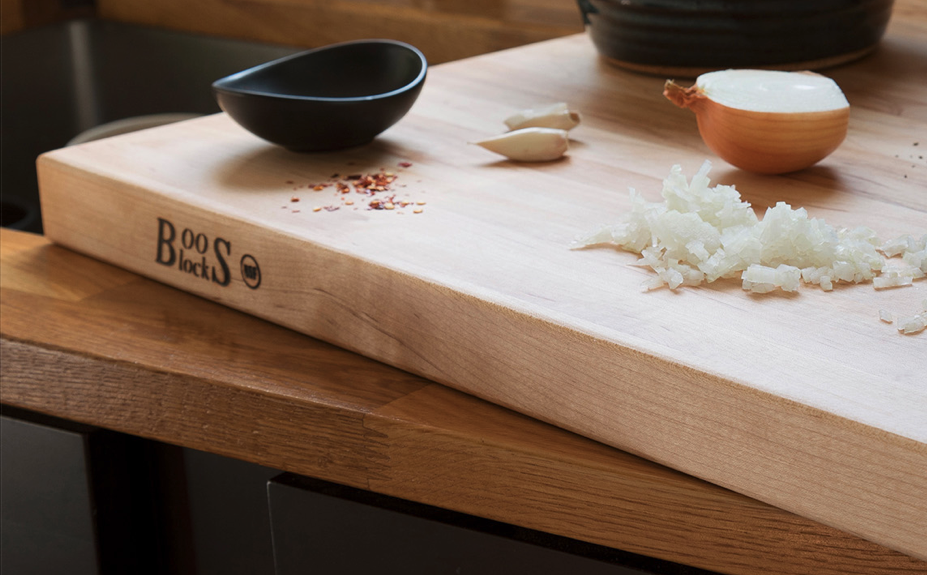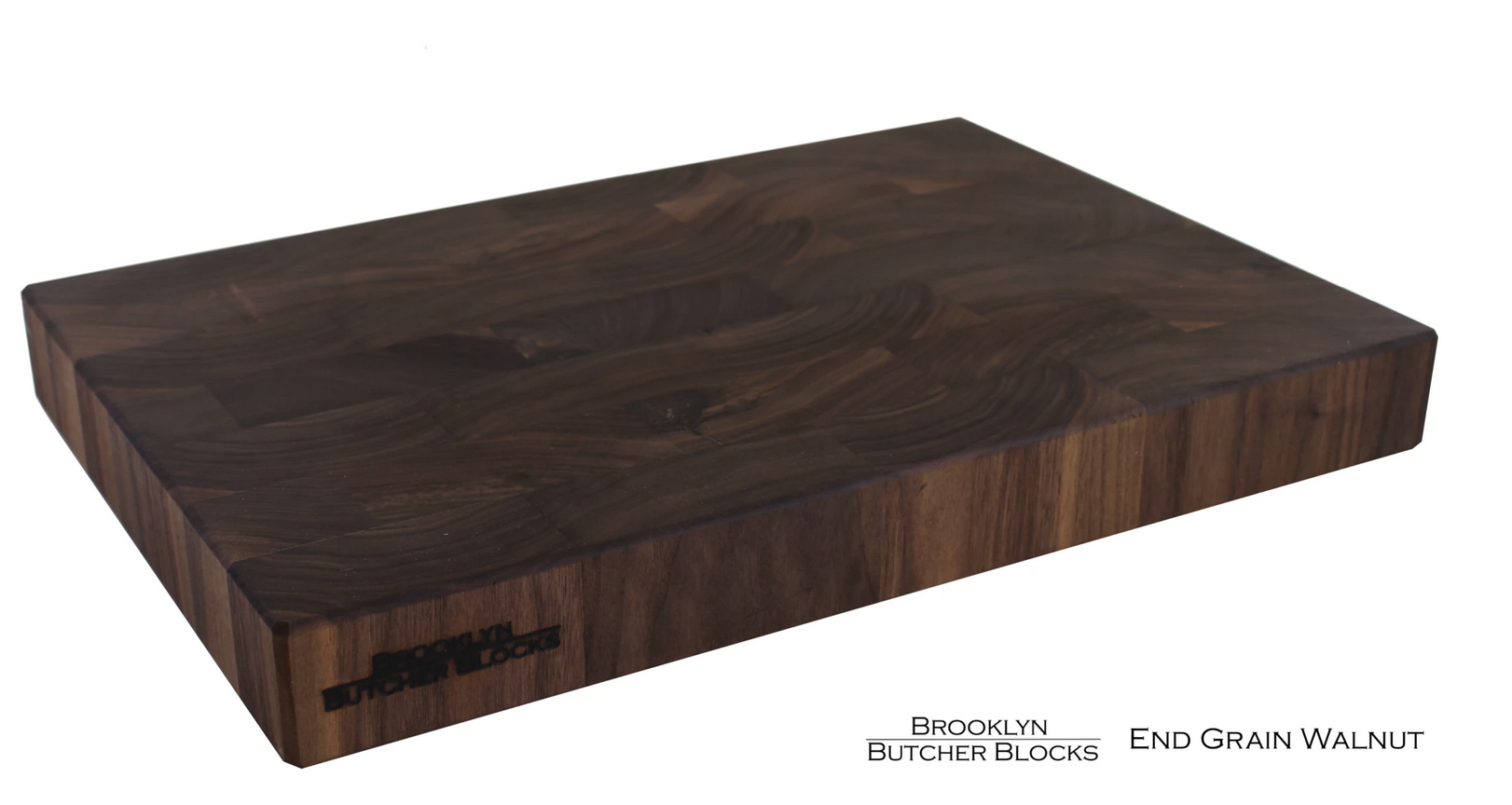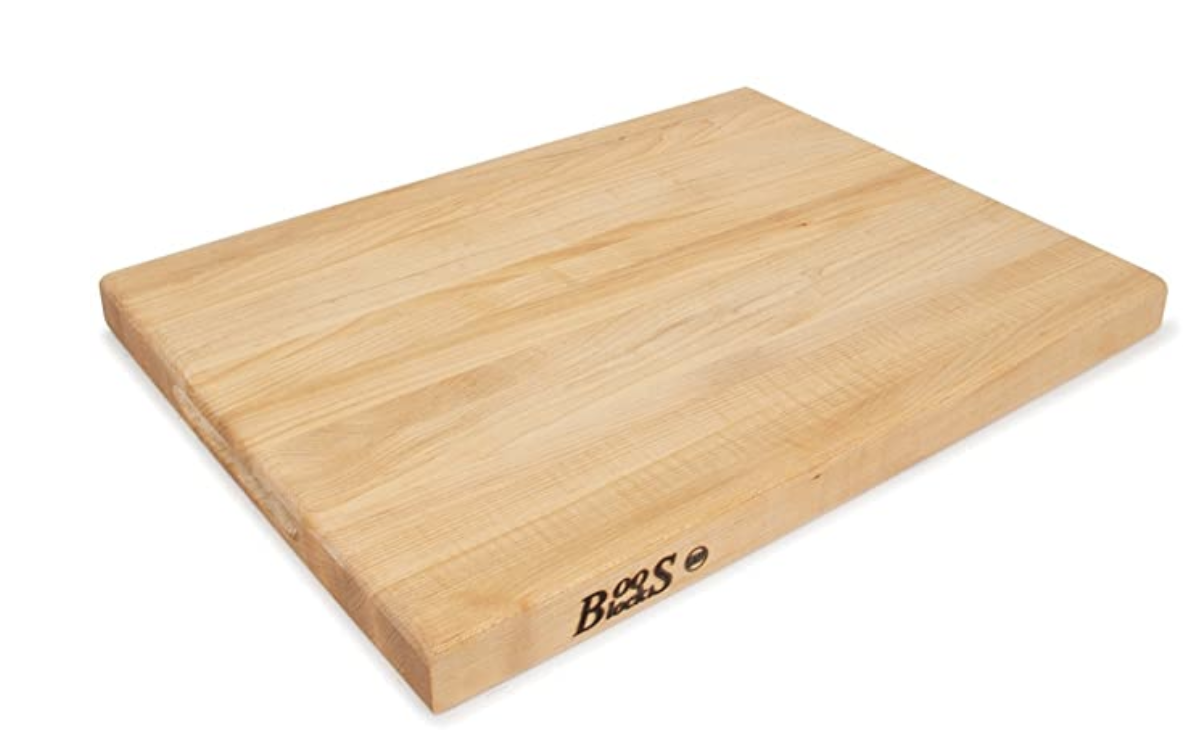Kitchen Essentials – The Secret is in the Board
By Chef David
A chef’s secret weapons are his or her essential kitchen tools. While there are not many must-haves, your choices can influence your cooking experience. Once I thought all I needed was a good pot, a sharp knife, and an idea; now I recognize that having the right working surface matters. Cutting boards provide a customized cutting surface, but not all boards are alike. They should be gentle on your knife blade, easy to clean, and maintain. While each chef has their favorite, overall, they agree wood boards are the best.
Material Matters
Cutting boards come in a wide variety of materials including wood, plastic, and glass. Glass is not recommended, it is not a forgiving material, which makes it hard on your knife, and noisy, each cut will resonate throughout your kitchen, and dull your blade. For the same reason, stone and marble cutting boards are not recommended. One chef suggested that these hardboards be repurposed into serving dishes.
Plastic is relatively inexpensive and was thought to be more sanitary than wood because it is less porous. But plastic boards scar easily, and once a plastic board is scratched the divots become places for bacteria to hide.
Wood boards get scratched too, but they can be sanded down to look like new. Surprisingly, researchers found that hardwoods, which are fine-grained, have a capillary system that pulls bacteria into their fibers leaving them to die as the board dries.
I find the cutting experience with wood is far smoother than with plastic boards, even for a novice cook. Wood boards minimize damage to your knife, keeping your knife sharper for longer.
Care and Maintenance
Wood boards require maintenance including oiling, to prevent warping and cracking. Unlike plastic boards, they should never be put into the dishwasher.
Avoid exposing your board to too much water, they should not be left to soak in the sink. I wash my board after every use and dry it. To prevent the wood from drying out, and avoid cracks, oil your board monthly or as needed with special wood oil. To tell if your board needs to be oiled, sprinkle a few drops of water and if it does not bead up, it’s time to reapply oil.
Personal Preference
Each chef has their favorite wooden cutting board. Basically, selecting the right wooden board is a matter of personal preference. There are differences in size and construction, some considerations include how much you cook, the knives you use, and the cooking space. For a recreational chef, convenience is most important. I want a board that expands my cutting surface and provides ample storage during preparation. My cutting board is large enough to hold the piles of sliced vegetables preventing them from sliding onto the countertop.
Chefs select a larger cutting board to provide a neat and organized surface to stage cut items for later use. I would recommend at a minimum using a board larger than your knife. The size of your board depends on the available counter space in your kitchen, which explains why some Chefs use a dedicated butcher block table that they cut directly on.
There are two Basic Types of Wooden Board Construction End-Grain and Edge-Grain
End-Grain boards, are produced when you crosscut the tree, exposing the tree’s rings. Because end-grain boards are more difficult to make, they tend to be more expensive and contain more glued seams compared to the long strips of wood used in an edge-grain. The glue seams can potentially make the board weaker.
Edge-Grain boards are produced when you cut the trunk vertically, exposing a side view of the fibers running lengthwise, cutting the wood with the grain. Edge grain boards are more likely to scar from the saws’ blade, they tend to be harder which can put increased wear on your knife.
What to consider before you Upgrade Boards
Upgrading my cutting boards was an extravagance, especially in a kosher kitchen when you need separate boards for Year-Round as well as a Kosher for Passover, or parve, fleshing, or dairy. I primarily use my cutting board for fruits and vegetables, onions, and garlic, so I splurged on my year-round parve cutting board.
Cutting boards can be either machine or handmade, the difference is in quality, material, and price. Most board manufacturers offer a wide range of products, which gives you options.
Begin by knowing YOUR why
A handmade cutting board can be a special gift for any occasion, with the price of wood boards ranging from $6 to $600. The higher price signifies workmanship and material. Think of it as commissioning a work of art, the caliber board can make it a signature piece. A high-end machine-made board is a vast step up from the mass-produced discount store off-the-shelf budget board.
If you want less expensive options, select a thick, good-quality wooden board. A board that feels flimsy probably is, and it will not hold up, some cheap boards end up warping or cracking in less than a year.
Always inspect your prospective board, and look for imperfections or fillers, this can be rough edges or dents in the wood. While it may sound picky, a small glitch can detract from your overall cooking experience.
Choose the Right Wood
When selecting a cutting board the type of wood makes a difference. Here again, it depends on personal preference. Some cooks use their cutting board to accessorize their kitchen, many select a maple board for this reason.
- Beech: Dense and visually improves with age becoming a deep red.
- Cherry: Color makes it attractive, but the wood is soft and may wear out faster.
- Maple: Durable and dense, requires maintenance because the lighter color shows stains.
- Oak: Porous which means it bows easily and should be disinfected often.
- Pine: Soft wood which will wear out faster and may impart a taste.
- Teak: Requires less upkeep but may be hard on your knife.
- Walnut: Happy medium between Cherry and Maple, nice on your knife.
Chef’s Pick
Upgrade – Brooklyn Butcher Blocks board has become a showpiece in my kitchen it truly is a work of art
Brooklyn Butcher Blocks end-grain board is handcrafted, and impressively well made. Their most popular product is a 12x18x1.75 Inches End-Grain Walnut Butcher Block. The board was almost too beautiful to use. The Walnut Butcher Block makes preparation a pleasure, because of the darker color of the wood, the cut marks don’t show easily. Brooklyn Butcher Blocks also makes a highly recommended edge-grain board at a lower price.
My first impression of the board was how solid the wood felt, and how substantial it was, it made my working space feel small. I was pleased that it was already waxed and oiled, requiring no immediate care. They also sell a quarterly care pack to maintain your board. The wide variety of wood available, allows you to select the board which fits your needs best.
Brooklyn Butcher Blocks, established in 2010, is owned and operated by Nils Wessell, a master craftsman from three generations of woodworkers. All materials are sourced in the US. Brooklyn Butcher Blocks is iconic and featured as a top pick in many culinary publications.
Workhorse – John Boos, a well-known quality brand
John Boos popular model is the Maple Wood Edge-Grain Reversible Cutting Board, 15x20x1.5 Inches. This board is thick, durable, and well-constructed. They also produce a proprietary wood care kit to maintain your boards. Most of Boos’ product line uses American Hard Rock Maple wood but they also have many other kinds of wood to choose from including American Cherry and American Black Walnut. While I tested an edge-grain board, they also make end-grain boards.
Boos board is a popular solid pick that will last you for many years of cooking if properly maintained. Boos boards are sturdy and large. The one we tested came with handgrips which made it easy to move.
Founded in 1887 by Conrad Boos, they have been serving the foodservice industry for over 130 years, expanding from cutting boards to providing an array of kitchen prep surfaces such as butcher blocks, work tables, carts, islands, and counters in wood and stainless steel. Boos sources their hardwood from NHLA-affiliated lumber mills in the USA located in Illinois, Michigan, Tennessee, Ohio, Pennsylvania, and New York.
Have fun in the kitchen
Cooking becomes more fun when you use the correct tools. Sure, you can cut on any surface, but the introduction of a professional cutting surface improves your culinary prowess, and most importantly reduces accidents. Upgrading to a real cutting board is almost a rite of passage, a transition from amateur to accomplished. Having the essential tools gives me the freedom to cook how I want.








